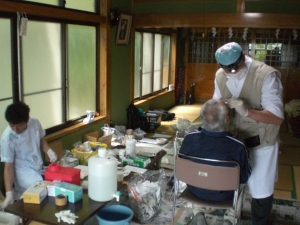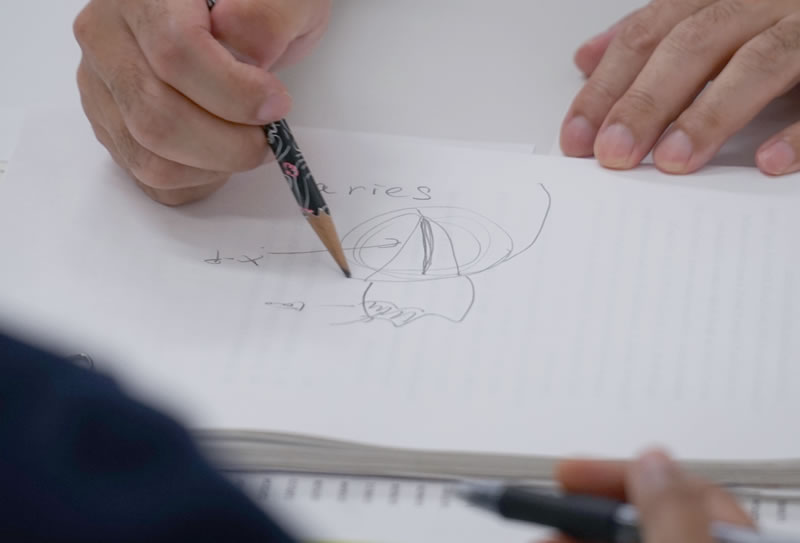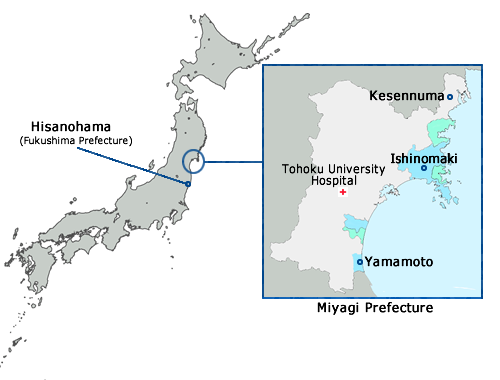Discovering Disaster Dentistry (Part 2 of 3)
Nicole Gunawansa | August 3rd, 2015
This interview was held on June 4th, 2015 in the Tohoku Medical Megabank Building
Part 2- Importance of Oral Hygiene in a Time of Crisis
Question 4: Please describe the role of dentistry in the disaster relief and recovery process?

Dr. Tsuboi and his colleagues provided the survivors dental treatment at the evacuation centers and private houses in the coastal area.
Dr. Tsuboi: The temporary dental clinic established after the disaster were active for 6 months, but after 4 months we started to transfer the oral health recovery efforts to the local dental clinics in Miyagi prefecture. Many dental clinics in this prefecture were damaged during the disaster, particularly in Kesennuma and Ishinomaki. After about 2 month a major of these clinics had been rebuilt and were started to see patients again in hopes that life would return to normal. Considering that dentistry in Japan is traditionally performed by dental clinics in local towns, we felt that it was important to turn over our responsibilities to these clinics to help in the restoration of the affected areas.
The victim identification is actually still being continued, even now. This type of work is crucial during the immediate disaster aftermath---during the first 7 month following a disaster---, but even several years later the identification of missing victims is possible. As of this year, there are still 83 missing victims of the Great East Japan Earthquake who have yet to be identified.
Many countries do not involve dentistry in the disaster relief process. It is difficult to even find background research on this field since most research papers address victim identification in non-disaster settings. Yet, the field of disaster dentistry should not be neglected; we need to develop it to help the victims recover properly.
Question 5: What concerns do you believe have been brought about after the Great East Japan Earthquake regarding oral health? How are communities dealing with these problems?
Dr. Tsuboi: Water accessibility was inadequate and dental supplies (e.g. tooth brushes, tooth paste, etc.) were limited as a result of the disaster, and so oral health was unkempt. For example, dentures need to be cleaned regularly, but the evacuees did not have enough access to sanitation  stations in the evacuation facilities because these centers were very small and crowded. As a result, many elderly people suffered from a significant decline in their oral health, and some even made the decision to go without dentures for that period of time. These oral health issues were not just limited to the elderly with denture management problems. Lack of oral healthcare due to conditions of evacuation centers and limited of supplies is a serious matter that can result in infectious disease and even pneumonia if not corrected. Restricted availability to sanitation stations in evacuation centers is not something that we dentists can improve alone because it is hard to change the layout of such facilities given that people are only expected to evacuate for a short period of time. Nevertheless, change is necessary, and these issues need to be acknowledged and improved for the future.
stations in the evacuation facilities because these centers were very small and crowded. As a result, many elderly people suffered from a significant decline in their oral health, and some even made the decision to go without dentures for that period of time. These oral health issues were not just limited to the elderly with denture management problems. Lack of oral healthcare due to conditions of evacuation centers and limited of supplies is a serious matter that can result in infectious disease and even pneumonia if not corrected. Restricted availability to sanitation stations in evacuation centers is not something that we dentists can improve alone because it is hard to change the layout of such facilities given that people are only expected to evacuate for a short period of time. Nevertheless, change is necessary, and these issues need to be acknowledged and improved for the future.
Question 6: ToMMo has established a division of community oral health science. What was the motivation behind including oral health in ToMMo’s large scale cohort study?
Dr. Tsuboi: ToMMo is interested in how 3/11 affected human health. Oral health undeniably affects systemic health seeing as the mouth is the beginning of digestion, respiration, and general physical sustainability. Cavities and periodontal disease negatively impacts oral health, and in turn bad oral hygiene can affect the cardiovascular system, the immune system, cognition, and even pregnancy. It is normal for bacteria, particulates, and plaque to build up around teeth, but in the case of the disaster, people were unable to clear away the grim from their mouths on a daily basis. Thus, we are attempting to determine the impact of the disaster on oral health in the Tohoku region.

